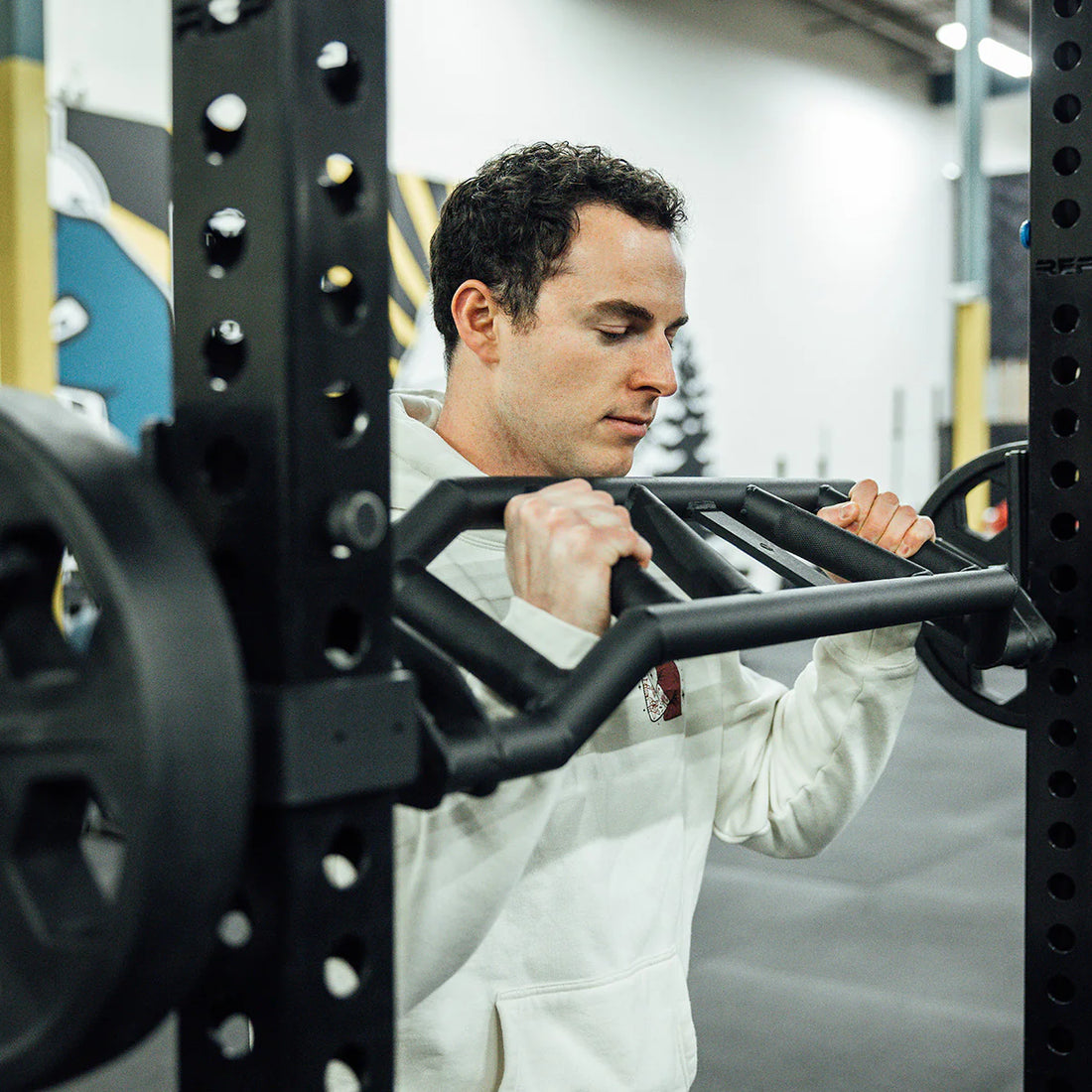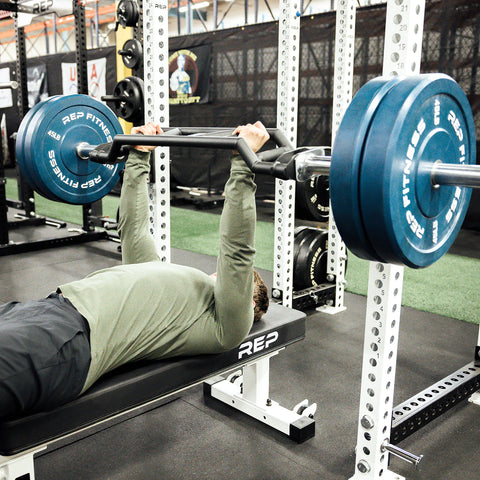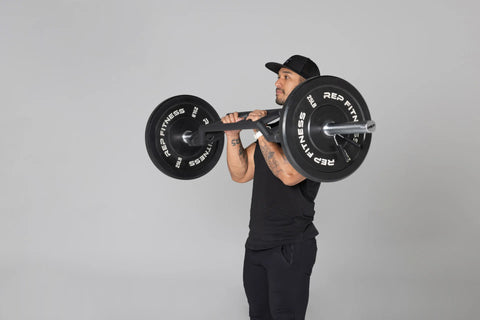
Cambered Swiss bar. Football bar. Multi-grip bar. Neutral grip bar. Call it what you want.
These are all variations of the same unique-looking barbell. This specialty bar was originally designed to allow athletes to continue bench pressing heavy with a reduced risk of shoulder injury. And while the neutral-grip hand variations (palms facing each other rather than away from the body) of this barbell are gentler on the shoulders when you bench press, there’s a ton more a Cambered Swiss Bar is great for. In fact, it's arguably one of the most underrated barbells out there.

Bet you haven’t tried all these exercises before. (Yeah, that’s a challenge!)
First Things First: What is a Cambered Swiss Bar?

The Cambered Swiss Bar has a loadable sleeve on each side (like a regular barbell), but with a ladder-like design in the middle. Often, some of those “rungs” are angled to create various grip options.
REP’s Cambered Swiss Bar is designed for greater range of motion. The camber offsets the weight from being in line with the bar, creating a pendulum effect, so you must engage more muscles to stabilize the bar, creating a different stimulus than a traditional barbell. The outermost handle creates a deficit. The deficit allows you to pull the bar down in a larger range of motion. On the REP bar, those outer handles are at a deficit and slight camber, so you get both.
CliffsNotes definition:
- Camber = Curve or bend in the bar that offsets the weight, creating an unstable, pendulum effect.
- Deficit: Larger range of motion.
Why People Love the Cambered Swiss Bar

The design of the Cambered Swiss Bar reduces the stress on your shoulders and wrists. At the same time, it demands more of your triceps. This makes it optimal for people with shoulder issues or a limited range of motion. It also is great for bodybuilders who want to pinpoint more specific muscles.
Ego check: Since the Cambered Swiss Bar demands more triceps (smaller muscles) than pecs and shoulders, you probably won’t be able to lift as much as you normally can on a straight bar.
Here are some more reasons people love the Cambered Swiss Bar:
- It keeps your wrists neutral, so they can’t "break" backward (a common technical problem with benching with a straight bar).
- It can improve your lockout by building your triceps strength, a critical component of that top range of motion on the bench press.
- It’s versatile for different sized lifters, thanks to the different handle widths.
- It’s less expensive than many other pieces of specialty equipment, especially considering its versatility.
How to Use the Cambered Swiss Bar
How to do a Cambered Bar Bench Press
- Set up the bench under the cambered bar in a power rack or bench station.
- Position the bar so the cambered part hangs lower than a standard barbell.
- Lie flat on the bench with your feet planted firmly on the floor.
- Grip the bar at shoulder-width or slightly wider, ensuring your wrists are straight and elbows are aligned.
- Unrack the bar, keeping your core tight and shoulders retracted.
- Lower the bar slowly, allowing the camber to bring the bar deeper toward your chest, but without bouncing or losing control.
- Pause briefly at the bottom to maintain tension.
- Press the bar up, extending your arms fully and locking out the elbows.
- Repeat for desired reps, maintaining control and form throughout the movement.
This movement allows for a greater range of motion and deeper stretch in the chest, so start with a lighter weight to get used to the camber.
Other Exercises on a Cambered Bar
Bench pressing is just the beginning of what you can do on a Cambered Swiss Bar. You can also do:
How to do Cambered Bar Curls
- Choose a cambered (EZ) bar with the desired weight and grip it at the angled sections for comfort and wrist alignment.
- Stand upright, feet shoulder-width apart, with a slight bend in your knees and your core engaged.
- Hold the bar in front of your thighs with an underhand grip (palms facing up), keeping your elbows close to your sides.
- Curl the bar upward by flexing your elbows, keeping your upper arms stationary.
- Focus on squeezing your biceps at the top of the movement without letting your elbows drift forward.
- Lower the bar slowly, controlling the descent and fully extending your arms without locking your elbows.
- Repeat for desired reps, keeping your form tight and avoiding swinging or using momentum.
The cambered bar helps reduce strain on the wrists and allows for a more comfortable and effective bicep workout.
More Ways to Use a Cambered Swiss Bar
- Ab rollouts
- Incline presses
- Floor presses
- Front squats
- Zercher squats
- Triceps extensions
- Front raises
- Clean and presses (narrow grip)
- Chin-ups (place the bar on top of a squat rack)
- Jammer presses
- Suitcase carries
- Pullovers
- Stiff-legged deadlifts
- Single-leg deadlifts
- JM Presses
- Inverted rows (put the bar on your rack safeties)
Want More of a Challenge?
Tip: Look for a Cambered Swiss Bar with knurling to help with grip on heavier lifts, especially pulling movements. Bonus points if you can find a Cambered Swiss Bar that’s long enough to rack on a power rack. This will help with loading weights and getting into optimal form for many of the exercises.

NEWSLETTER SIGNUP
Product launch information, promotions, blogs, and REP news.













